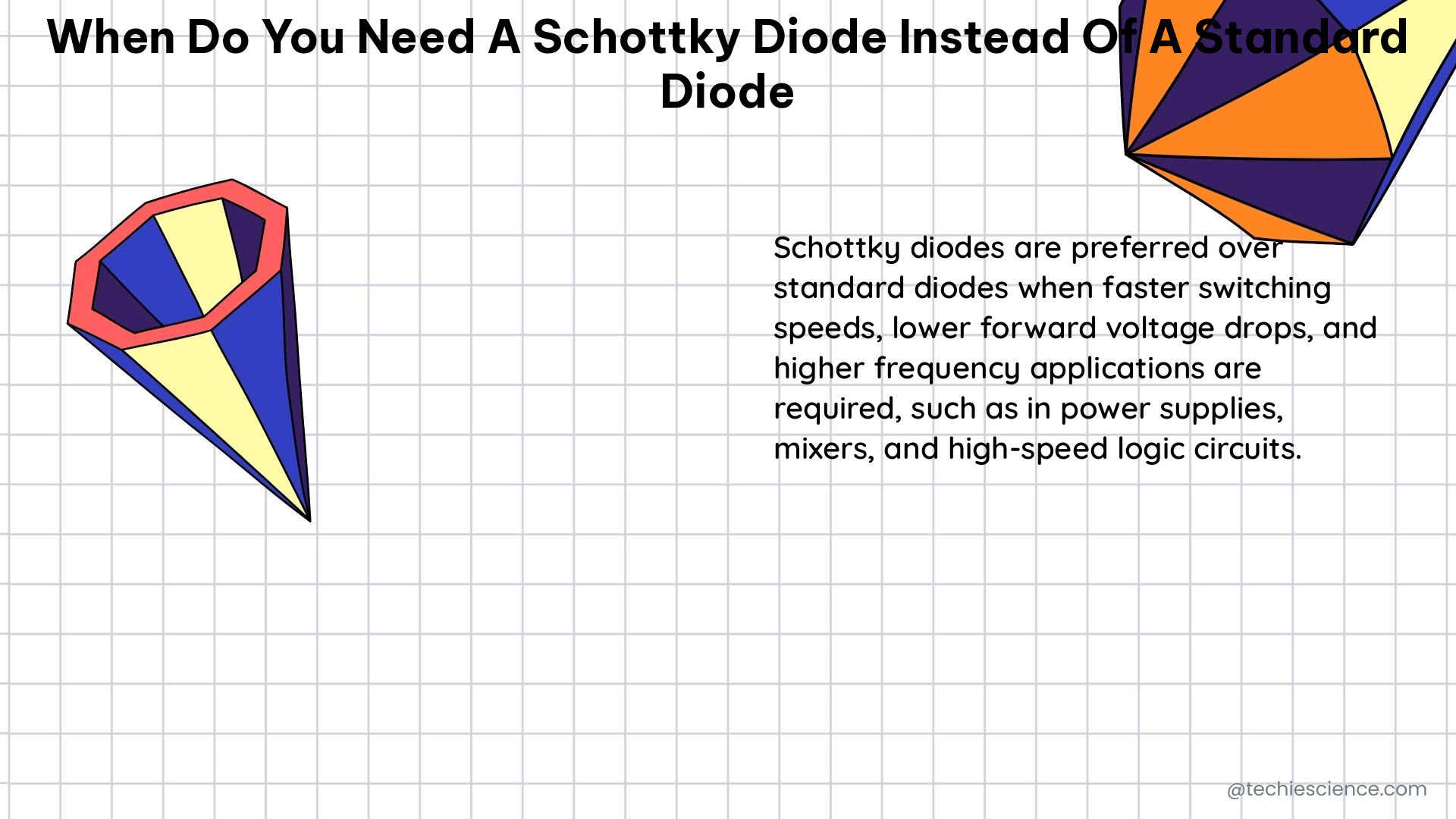Schottky diodes are a specialized type of semiconductor diode that offer unique characteristics and advantages over traditional silicon p-n junction diodes in certain applications. Understanding the key differences between Schottky and standard diodes is crucial in determining when to use a Schottky diode instead of a standard diode.
Schottky Diode Construction and Characteristics
Schottky diodes are constructed with a thin layer of metal (typically platinum, palladium, or tungsten) bonded to an n-type semiconductor material, usually silicon. This creates a Metal-Semiconductor (M-S) junction, which is different from the p-n junction found in standard silicon diodes.
The M-S junction in a Schottky diode results in a narrower depletion region and a lower built-in potential barrier compared to a p-n junction. This gives Schottky diodes several distinct advantages and disadvantages:
Advantages of Schottky Diodes
-
Lower Forward Voltage Drop: Schottky diodes typically have a forward voltage drop of 0.3-0.4 V, compared to 0.6-0.7 V for standard silicon diodes. This lower voltage drop can be beneficial in applications where minimizing power loss is important, such as in power supplies and voltage regulators.
-
Faster Switching Speed: Schottky diodes have a much faster reverse recovery time, typically in the range of nanoseconds, compared to microseconds for standard silicon diodes. This makes them well-suited for high-frequency switching applications, such as in switching power supplies and RF circuits.
-
Higher Frequency Operation: The fast switching speed of Schottky diodes allows them to be used in circuits operating at higher frequencies, up to the gigahertz range, without significant performance degradation.
Disadvantages of Schottky Diodes
-
Higher Reverse Leakage Current: Schottky diodes have a higher reverse leakage current compared to standard silicon diodes, which can be a concern in applications where low leakage current is critical, such as in high-impedance circuits.
-
Lower Maximum Reverse Voltage: Schottky diodes typically have a lower maximum reverse voltage rating, typically in the range of 20-200 V, compared to standard silicon diodes, which can have ratings up to 1000 V or more. This can be a limitation in applications that require high reverse voltage handling.
-
Temperature Sensitivity: Schottky diodes are more sensitive to temperature changes, with their forward voltage drop and reverse leakage current being more affected by temperature variations compared to standard silicon diodes.
When to Use a Schottky Diode Instead of a Standard Diode

Given the unique characteristics of Schottky diodes, they are often the preferred choice in the following applications:
-
Switching Power Supplies: Schottky diodes are commonly used as rectifiers and flyback diodes in switching power supplies due to their fast switching speed and low forward voltage drop, which can improve efficiency and reduce power dissipation.
-
RF and High-Frequency Circuits: Schottky diodes are well-suited for use in RF and high-frequency circuits, such as mixers, detectors, and clamps, due to their fast switching capabilities and high-frequency operation.
-
Voltage Clamping: Schottky diodes can be used as voltage clamping devices to protect sensitive electronic components from voltage spikes and transients, thanks to their low forward voltage drop.
-
Low-Power Applications: In applications where power consumption is a concern, such as in battery-powered devices, Schottky diodes can be advantageous due to their lower forward voltage drop, which can improve overall efficiency.
-
High-Speed Switching: Schottky diodes are often used in high-speed switching applications, such as in pulse-width modulation (PWM) circuits, where their fast reverse recovery time is crucial for maintaining proper operation.
-
Reverse Polarity Protection: Schottky diodes can be used to provide reverse polarity protection in circuits, as their lower forward voltage drop can minimize the voltage drop across the protection circuit.
It’s important to note that the choice between a Schottky diode and a standard silicon diode should be based on a careful evaluation of the specific requirements of the circuit, including factors such as operating frequency, power dissipation, reverse voltage handling, and leakage current requirements.
Reference:
- Do Your Circuits Need a Schottky Diode? – PCB Design & Analysis
- Normal vs Schottky: which diode to use in a basic “protection” situation
- Schottky vs Standard Diode – TechForum DigiKey
- Do I need a Schottky diode as a flyback diode with PWM @ 30khz?
- Difference between a normal diode and a Schottky diode

The lambdageeks.com Core SME Team is a group of experienced subject matter experts from diverse scientific and technical fields including Physics, Chemistry, Technology,Electronics & Electrical Engineering, Automotive, Mechanical Engineering. Our team collaborates to create high-quality, well-researched articles on a wide range of science and technology topics for the lambdageeks.com website.
All Our Senior SME are having more than 7 Years of experience in the respective fields . They are either Working Industry Professionals or assocaited With different Universities. Refer Our Authors Page to get to know About our Core SMEs.